What Is a Hexagonal Pyramid?
In geometry, a hexagonal pyramid is a pyramid with a hexagon as a base and 6 triangular lateral faces.
The lateral faces of a regular hexagonal pyramid may be the isosceles triangles or equilateral triangles. The lateral faces join together at a common point called apex.
A hexagonal pyramid has only 1 base in the shape of a hexagon. It has 7 faces, 7 vertices, and 12 edges.

A pyramid is a 3D figure or a geometric solid. It has a flat polygon base. All the other faces are triangles and are called lateral faces.
Different types of pyramids are named after the shape of their bases. For example, a pyramid with a triangle for a base is called a triangular pyramid. A square pyramid has a square base. Similarly a hexagonal pyramid has a hexagonal base.
Take a look at the image given below to know various types of pyramids.
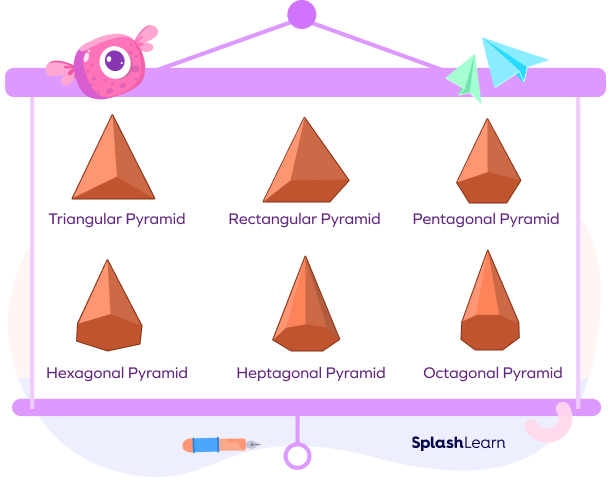
Definition of Hexagonal Pyramid
A hexagonal pyramid is a 3D figure that has the base in the shape of a hexagon and the sides or faces in the shape of a triangle. A hexagonal pyramid is also known as a heptahedron.
- A regular hexagonal pyramid has a regular hexagon at its base. It is characterized by a straight and uniform structure. The lateral faces of a regular pyramid are congruent isosceles triangles.
- An irregular hexagonal pyramid is a pyramid whose base is an irregular hexagon.
- A right regular pyramid is a hexagonal pyramid with a regular hexagon at its base. Its apex is right above the center of the base, and it forms a right angle with the center of the base and any other vertex.
- The pyramid is considered oblique when not all of its lateral triangles are isosceles, and its apex is not aligned with the center of the base.
Recommended Worksheets
Properties of Hexagonal Pyramid
Hexagonal pyramid has some unique properties. Let’s take a look at the image given below and learn the properties.
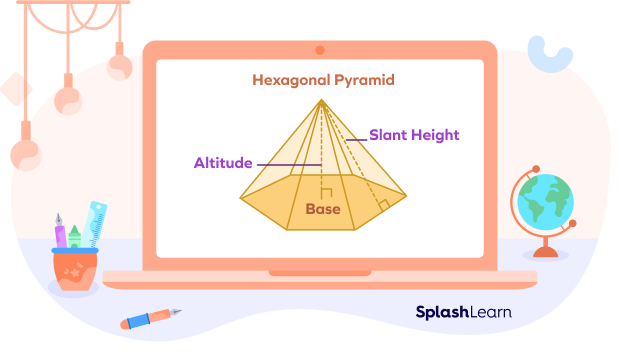
- The base of a hexagonal pyramid is a hexagon.
- Hexagonal pyramid is a polyhedron.
- 6 isosceles triangles make up the lateral faces of a hexagonal pyramid, which are raised up against the base and joined at a common point at the top known as the apex.
- A hexagonal pyramid has a total of 7 vertices, 6 at its base and 1 at its top.
- A hexagonal pyramid has 12 edges out of which 6 connect the triangle edges to the main vertex and the 6 edges of the base.
- A hexagonal pyramid has seven faces in total, one for each side of the triangle, plus one base.
Volume of Hexagonal Pyramid
Volume is defined as the space occupied within the boundaries of an object in three-dimensional space. Thus, the volume of the hexagonal pyramid is the space occupied by the hexagonal pyramid. It is measured in cubic units.
Take a look at the image given below. It shows the dimensions of a hexagonal pyramid that are used to find the volume of the pyramid.
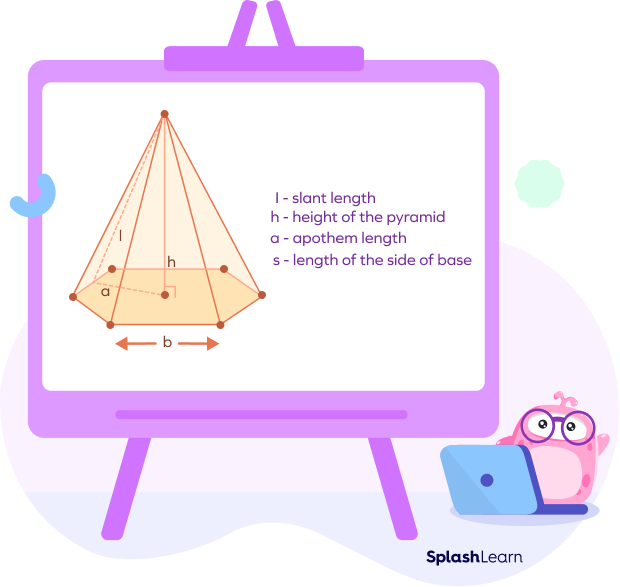
Hexagonal pyramid volume formula is given by
Volume of Hexagonal Pyramid = (a × b × h) cubic units
where, a = apothem length = length from the center of the base to any point on the base
b = base length
h = height of the pyramid
Note: If the triangles are equilateral triangles and the apothem is not given, we can find the volume using the following formula.
Volume of hexagonal Pyramid $= \frac{\sqrt{3}}{2} \times b^{2} \times h$
where
b is the side of the base and h is the height of the hexagonal pyramid
Surface Area of Hexagonal Pyramid
The total surface area of a regular pyramid is the sum of the areas of its lateral faces and its base. Let us see both the formula of the hexagonal pyramid – base area and surface area.
The formula for surface area of base is
- Base Area of Hexagonal Pyramid = 3ab
where, a = apothem length
b = base length
- Lateral Surface Area of Hexagonal Pyramid = 3bs
where, b = base length
s = slant height
- Total Surface Area (TSA) of Hexagonal Pyramid = (3ab + 3bs)
where, a = apothem length
b = base length
s = slant height
Hexagonal Pyramid Net
The net of a hexagonal pyramid is a two-dimensional shape that, when folded and assembled, creates a hexagonal pyramid. When the pyramid is unfolded or flattened, you can observe the six triangles and a hexagonal base.
Take a look at the image given below to understand the structure better.

Does a Hexagonal Pyramid Have Rectangular Faces?
Hexagonal pyramid has triangular lateral faces while the base has a hexagonal face. On the other hand, a hexagonal prism has 6 rectangular lateral faces and 2 hexagonal top and bottom faces.
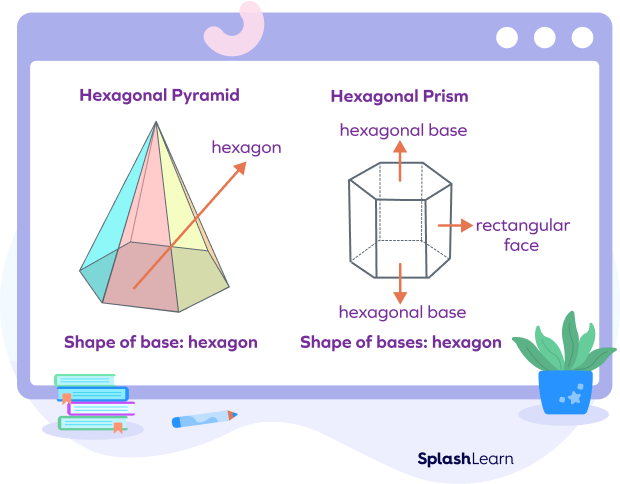
Faces, Edges, and Vertices of a Hexagonal Pyramid
- How Many Vertices Does a Hexagonal Pyramid Have?
A hexagonal pyramid has a hexagonal shaped base with 6 isosceles triangular lateral faces. The hexagonal base has 6 vertices. There is one vertex at which all the six lateral triangles meet. So, a hexagonal pyramid has 7 vertices in total.
- How Many Faces Does a Hexagonal Pyramid Have?
A hexagonal pyramid has a hexagonal shaped base with 6 isosceles triangular lateral faces.It has a face for each side plus the base, and so it has a total of 7 faces.
- How Many Edges Does a Hexagonal Pyramid Have?
A hexagonal pyramid has 12 edges. 6 edges on the base and 6 edges connecting each of the hexagon’s vertices to the peak of the pyramid.
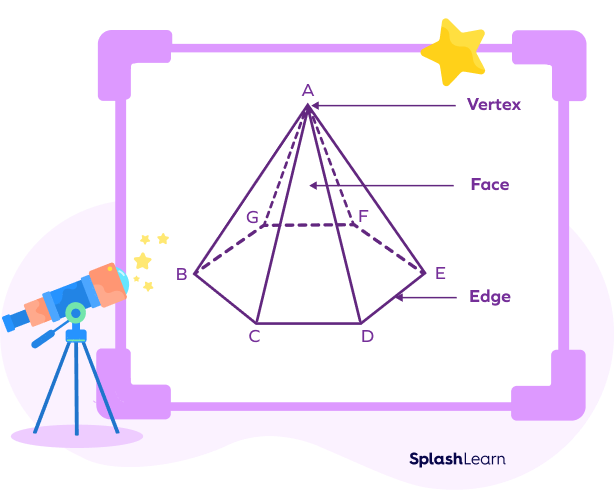
Facts about Hexagonal Pyramid
- A hexagonal pyramid has 7 faces, 7 vertices, and 12 edges.
- The volume of the hexagonal pyramid is the space occupied by the hexagonal pyramid and is calculated using the formula $V = a \times b \times h$
- where, a = apothem length, b = base length and h = height of the pyramid.
- A hexagonal pyramid is also called a heptahedron. It is a polyhedron.
- Surface area of a regular hexagonal pyramid = (3ab + 3bs) square units
- where, a is the apothem of the pyramid, b is the base, s is the slant height of the pyramid.
Conclusion
In this article, we learned about the hexagonal pyramid, its properties, and important formulas to find its volume and the surface area. Let’s solve some examples and practice MCQs for better comprehension.
Solved Examples on Hexagonal Pyramid
Example 1: Calculate the volume of a hexagonal pyramid with apothem length of 4 in, base length as 5 in, and height as 6 in.
Solution:
a = Apothem length = 4 in.
b = Base length = 5 in
h = Height = 6 in
Hexagonal pyramid volume = a × b × h
Volume = 4 × 5 × 6
Volume $= 120\; in^{3}$
The volume of the hexagonal pyramid is $120\; in^{3}$.
Example 2: Calculate the base area and surface area of a hexagonal pyramid, if the apothem length is 8 inches, base length is 12 inches, and slant height is 16 inches.
Solution:
Apothem length = 8 inches.
Base length = 12 inches
Slant height = 16 inches
- Base area = 3ab
Base area = 3 × 8 ×12
Base area $= 288\; in^{2}$
- Lateral surface area = 3bs
Lateral surface area = 3 × 12 × 16
Lateral surface area $= 576\; in^{2}$
- Surface area = (3ab + 3bs)
Surface area = (288 + 576)
Surface area $= 864\; in^{2}$
The base area and surface area of hexagonal pyramid is 288 in2 and 864 in2 respectively.
Example 3: Lisa has a hexagonal pyramid shaped toy with apothem length of 2 in, base length as 4 in and height of 6 in. What is the volume of the toy?
Solution:
Apothem length = 2 in
Base length = 4 in
Height = 6 in
Hexagonal pyramid volume = a × b × h
Volume = 2 × 4 × 6
Volume $= 48\; in^{3}$
The volume of the toy is $48\; in^{3}$.
Example 4: Find the height of a hexagonal pyramid when the volume (V) of the pyramid is 169 in3, the base (b) length of the pyramid is 10 inches and the apothem (a) of the pyramid is 8 inches
Solution:
Volume $= 169\; in^{3}$
a = 8 inches
b = 10 inches.
h = ?
Volume of hexagonal pyramid $= a × b × h$
169 = 8 × 10 × h
h $= \frac{169}{80}$
h = 2.11 inches.
Thus, the height of the hexagonal pyramid is 2.11 inches.
Practice Problems on Hexagonal Pyramid
Hexagonal Pyramid - Definition, Properties, Formulas, Examples
Which of the following is an incorrect statement about a hexagonal pyramid?
A hexagonal pyramid has a hexagonal shaped base with 6 isosceles triangular lateral faces.It has a face for each side plus the base, and so it has a total of 7 faces.
Identify the hexagonal pyramid from the shapes given below.
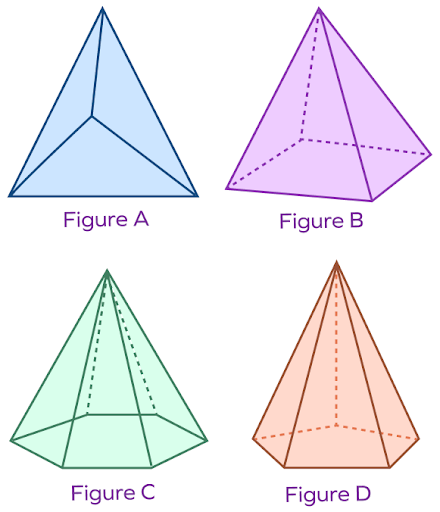
A hexagonal pyramid has a hexagonal base, which means its base has 6 edges.Thus, the figure C is a hexagonal pyramid.
Base area of the hexagonal pyramid is calculated using the formula _____________.
Base Area of Hexagonal pyramid = 3ab square units
where, a = apothem length, b = base length
The base of a hexagonal pyramid has _________ edges.
The base of a hexagonal pyramid is a hexagon. It has 6 edges.
Six ________ triangles make up the lateral faces of a regular hexagonal pyramid.
A hexagonal pyramid has a hexagonal shaped base with 6 isosceles triangular lateral faces.
Frequently Asked Questions about Hexagonal Pyramid
Why is a hexagonal pyramid also known as a heptahedron?
A heptahedron is a solid figure with seven plane faces. Hexagonal pyramid is also known as a heptahedron since a hexagonal pyramid consists of 7 faces, which includes a hexagonal base and 6 isosceles triangular lateral faces.
Is a pentagonal prism also a heptahedron?
A pentagonal prism is a prism that has two pentagonal bases like top and bottom and five rectangular sides. As it has 7 faces, 10 vertices and 15 edges, it can also be called a heptahedron.
What is a polygon with one million sides called?
A polygon with one million sides is called a Megagon. It has 1000000 edges and vertices.
How do you find the perimeter of a hexagonal base of a hexagonal pyramid?
The perimeter of a regular hexagon is just the sum of all 6 sides. Because it’s a regular hexagon, the perimeter is just six times one side.The formula for finding the perimeter of the hexagonal base is
Perimeter ( L ) = 6a
Where,
L = Perimeter
a = Side Value
How many rectangular faces does a Hexagonal Pyramid have?
It has a hexagonal base with six triangular faces meeting at a point on the top.
How many bases does a Hexagonal Pyramid have?
A hexagonal pyramid has only 1 base in the shape of a hexagon.



















